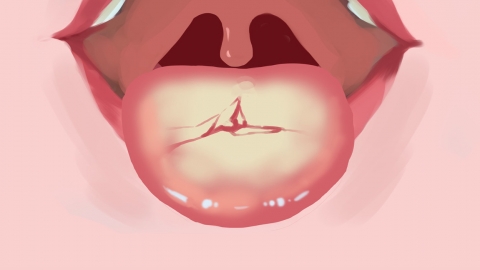White tongue coating with tooth marks and cracks in the middle: What does it mean?
Generally, white tongue coating with tooth marks and cracks in the middle may be caused by improper diet, poor oral hygiene, spleen and stomach weakness, oral mucosal disease, gastroesophageal reflux disease (GERD), and other factors. It is recommended to seek timely medical consultation to identify the underlying cause and receive appropriate treatment under a doctor's guidance. The specific analysis is as follows:

1. Improper Diet: Long-term excessive consumption of raw, cold, or greasy foods increases the digestive burden on the spleen and stomach, leading to thick white tongue coating. The tongue may develop tooth marks due to pressure from teeth, and dry mucosa may cause cracks. Adjust the diet by reducing raw, cold, and greasy foods, incorporating more easily digestible foods like yam and millet, maintaining regular meal times, and avoiding overeating.
2. Poor Oral Hygiene: Inadequate oral cleaning allows food debris to accumulate on the tongue coating, causing the tongue coating to turn white. Bacterial proliferation may irritate the mucosa, leading to cracks, and tongue swelling may result in tooth marks. Brush teeth thoroughly in the morning and evening, rinse after meals, use a tongue brush to clean the tongue coating, maintain oral hygiene, and reduce bacterial growth.
3. Spleen and Stomach Weakness: Weakened function of the spleen and stomach in transforming and transporting fluids may lead to internal accumulation of dampness, resulting in white tongue coating with tooth marks. Insufficient production of qi and blood may lead to poor nourishment of the tongue's mucosa, causing cracks, accompanied by abdominal distension and fatigue. Patients may follow medical advice to use herbal remedies such as Shen Ling Bai Zhu San, Xiang Sha Liu Jun Wan, or Ren Shen Jian Pi Wan for regulation. Avoid excessive fatigue and keep the abdomen warm.
4. Oral Mucosal Disease: Conditions such as fissured tongue (scrotal tongue) can cause grooves of varying depths on the tongue surface, where food debris may accumulate, causing white tongue coating. Tongue enlargement may lead to tooth marks and may be accompanied by mild pain. Patients may follow medical advice to use medications such as compound chlorhexidine mouthwash, Kangfuxin solution, or vitamin B2 tablets for symptom relief. Rinse the mouth with warm water after meals to clean food debris from the cracks and avoid irritating the mucosa.
5. Gastroesophageal Reflux Disease (GERD): Gastric contents may reflux into the esophagus and even the oral cavity, irritating the tongue surface and causing white tongue coating. Stomach acid may damage the mucosa, leading to cracks. Gastrointestinal discomfort may affect the function of the spleen and stomach, resulting in tooth marks, accompanied by acid regurgitation and heartburn. Patients may follow medical advice to take medications such as omeprazole enteric-coated capsules, domperidone tablets, or aluminum magnesium carbonate chewable tablets for treatment.
Maintain a light diet in daily life, avoid excessively hot or spicy foods that may irritate the oral mucosa, maintain regular作息 (作息 should be translated as "作息" in English, but since it's not directly translatable, it's better to use "作息" or explain as "rest and work patterns"), and improve lifestyle habits to help alleviate symptoms.







